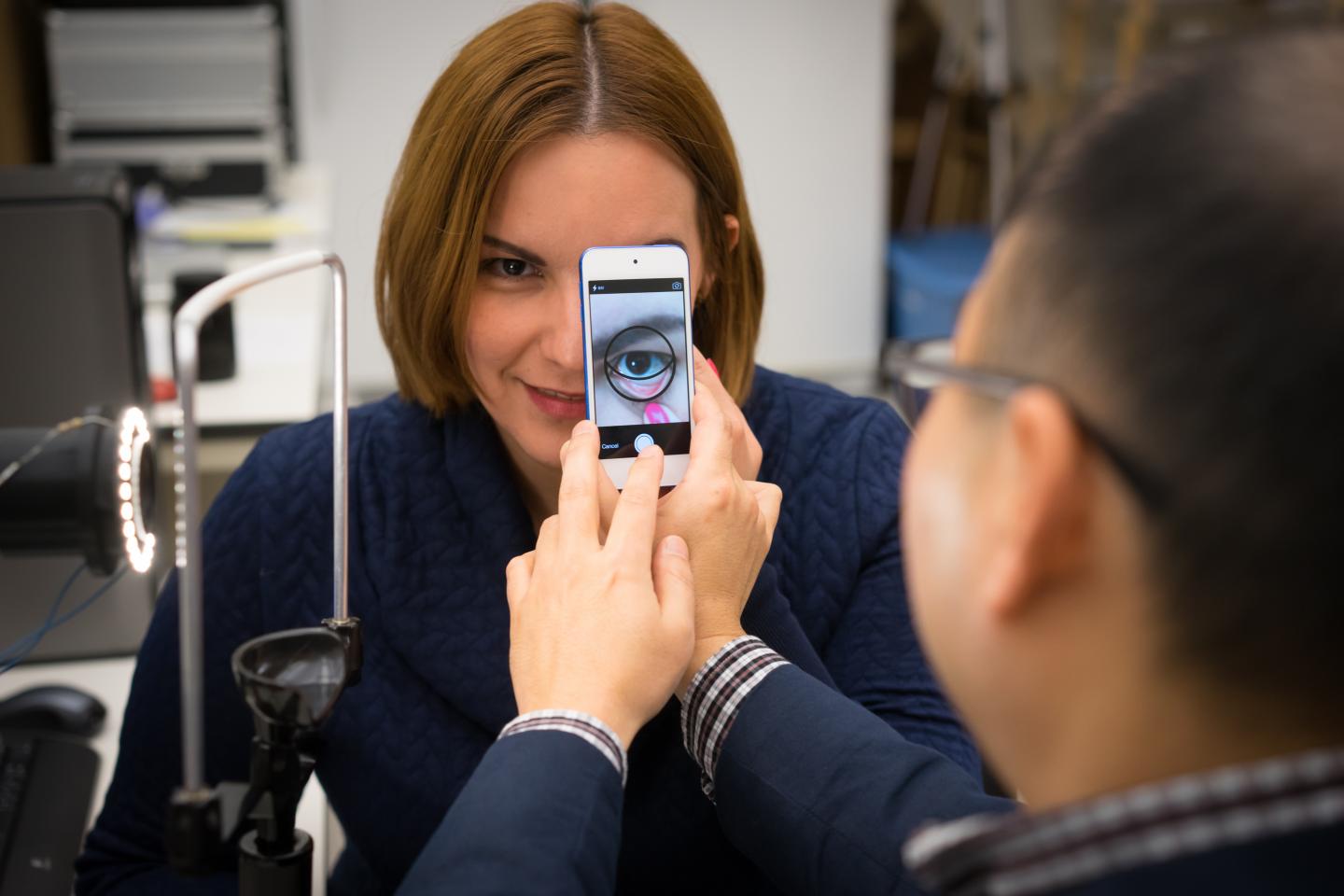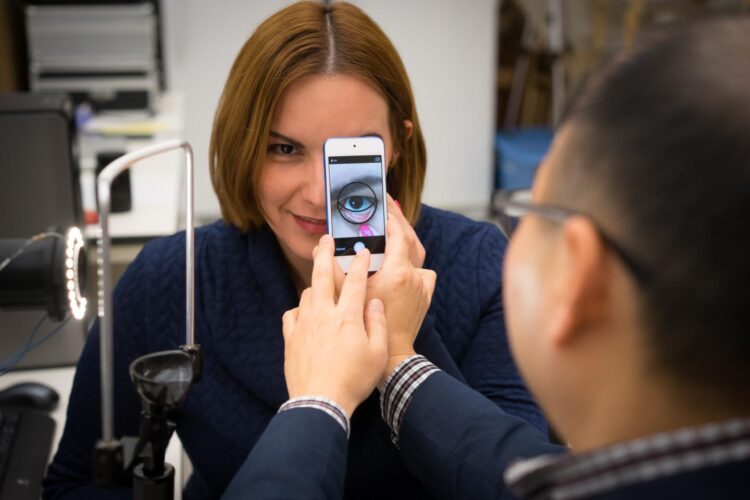Smartphone-based technique can help doctors assess anemia and blood disorders

Credit: Young Kim, Purdue University
WASHINGTON — Researchers have developed a way to use smartphone images of a person’s eyelids to assess blood hemoglobin levels. The ability to perform one of the most common clinical lab tests without a blood draw could help reduce the need for in-person clinic visits, make it easier to monitor patients who are in critical condition, and improve care in low- and middle-income countries where access to testing laboratories is limited.
“Our new mobile health approach paves the way for bedside or remote testing of blood hemoglobin levels for detecting anemia, acute kidney injury and hemorrhages, or for assessing blood disorders such as sickle cell anemia.” said research team leader Young Kim from Purdue University. “The COVID-19 pandemic has greatly increased awareness of the need for expanded mobile health and telemedicine services.”
Kim and colleagues from the University of Indianapolis, Vanderbilt University School of Medicine in the US and Moi University School of Medicine in Kenya report the new approach in Optica, The Optical Society’s journal for high impact research.
The researchers used software to transform the built-in camera of a smartphone into a hyperspectral imager that reliably measures hemoglobin levels (a measure of the oxygen-carrying capacity of blood) without the need for any hardware modifications or accessories. A pilot clinical test with volunteers at the Moi University Teaching and Referral Hospital showed that prediction errors for the smartphone technique were within 5 to 10 percent of those measured with clinical laboratory blood.
Kim’s lab focuses on developing healthcare technologies that are first designed and tested in the resource-limited settings of low- and middle-income countries. These innovations are then applied to important health challenges in developed countries such as the US.
“This new technology could be very useful for detecting anemia, which is characterized by low levels of blood hemoglobin,” said Kim. “This is a major public health problem in developing countries, but can also be caused by cancer and cancer treatments.”
Spectral information from a smartphone
Spectroscopic analysis is commonly used to measure blood hemoglobin content because it has a distinct light absorption spectrum, or fingerprint, in the visible wavelength range. However, this type of analysis typically requires bulky and costly optical components.
The researchers created a mobile health version of this analysis by using an approach known as spectral super-resolution spectroscopy. This technique uses software to virtually convert photos acquired with low-resolution systems such as a smartphone camera into high-resolution digital spectral signals.
The researchers selected the inner eyelid as a sensing site because microvasculature is easily visible there; it is easy to access and has relatively uniform redness. The inner eyelid is also not affected by skin color, which eliminates the need for any personal calibrations.
To perform a blood hemoglobin measurement with the new technique, the patient pulls down the inner eyelid to expose the small blood vessels underneath. A healthcare professional or trained person then uses the smartphone app developed by the researchers to take pictures of the eyelids. A spectral super-resolution algorithm is applied to extract the detailed spectral information from the camera’s images and then another computational algorithm quantifies the blood hemoglobin content by detecting its unique spectral features.
The mobile app includes several features designed to stabilize smartphone image quality and synchronize the smartphone flashlight to obtain consistent images. It also provides eyelid-shaped guidelines on the screen to ensure that users maintain a consistent distance between the smartphone camera and the patient’s eyelid. Although the spectral information is currently extracted using an algorithm on a separate computer, the researchers expect that the algorithm could be incorporated into the mobile app.
Clinical testing
The researchers tested the new technique with 153 volunteers who were referred for conventional blood tests at the Moi University Teaching and Referral Hospital. They used data from a randomly selected group of 138 patients to train the algorithm, then tested the mobile health app with the remaining 15 volunteers. The results showed that the mobile health test could provide measurements comparable to traditional blood tests over a wide range of blood hemoglobin values.
In a separate clinical study, the mobile app is being used to assess oncology patients at the Indiana University Simon Cancer Center. The researchers are also working with the University of Rwanda to conduct further studies and are planning to partner with the Shrimad Rajchandra Hospital in India to use the mobile health tool to assess nutritional status, anemia, and sickle cell disease in their patients.
“Our work shows that data-driven and data-centric light-based research can provide new ways to minimize hardware complexity and facilitate mobile health,” says Kim. “Combining the built-in sensors available in today’s smartphones with data-centric approaches can quicken the tempo of innovation and research translation in this area.”
###
Paper: S. M. Park, M. A. V. Visbal-Onufrak, M. Haque, M. C. Were, V. Naanyu, K. Hasan, Y. L. Kim “mHealth spectroscopy of blood hemoglobin with spectral super-resolution,” Optica, 7, 6, 563 (2020).
DOI: https:/
About Optica
Optica is an open-access, journal dedicated to the rapid dissemination of high-impact peer-reviewed research across the entire spectrum of optics and photonics. Published monthly by The Optical Society (OSA), Optica provides a forum for pioneering research to be swiftly accessed by the international community, whether that research is theoretical or experimental, fundamental or applied. Optica maintains a distinguished editorial board of more than 60 associate editors from around the world and is overseen by Editor-in-Chief Prem Kumar, Northwestern University, USA. For more information, visit Optica.
About The Optical Society
Founded in 1916, The Optical Society (OSA) is the leading professional organization for scientists, engineers, students and business leaders who fuel discoveries, shape real-life applications and accelerate achievements in the science of light. Through world-renowned publications, meetings and membership initiatives, OSA provides quality research, inspired interactions and dedicated resources for its extensive global network of optics and photonics experts. For more information, visit osa.org.
Media Contacts:
Aaron Cohen
(301) 633-6773
[email protected]
Media Contact
James Merrick
[email protected]
Related Journal Article
http://dx.





